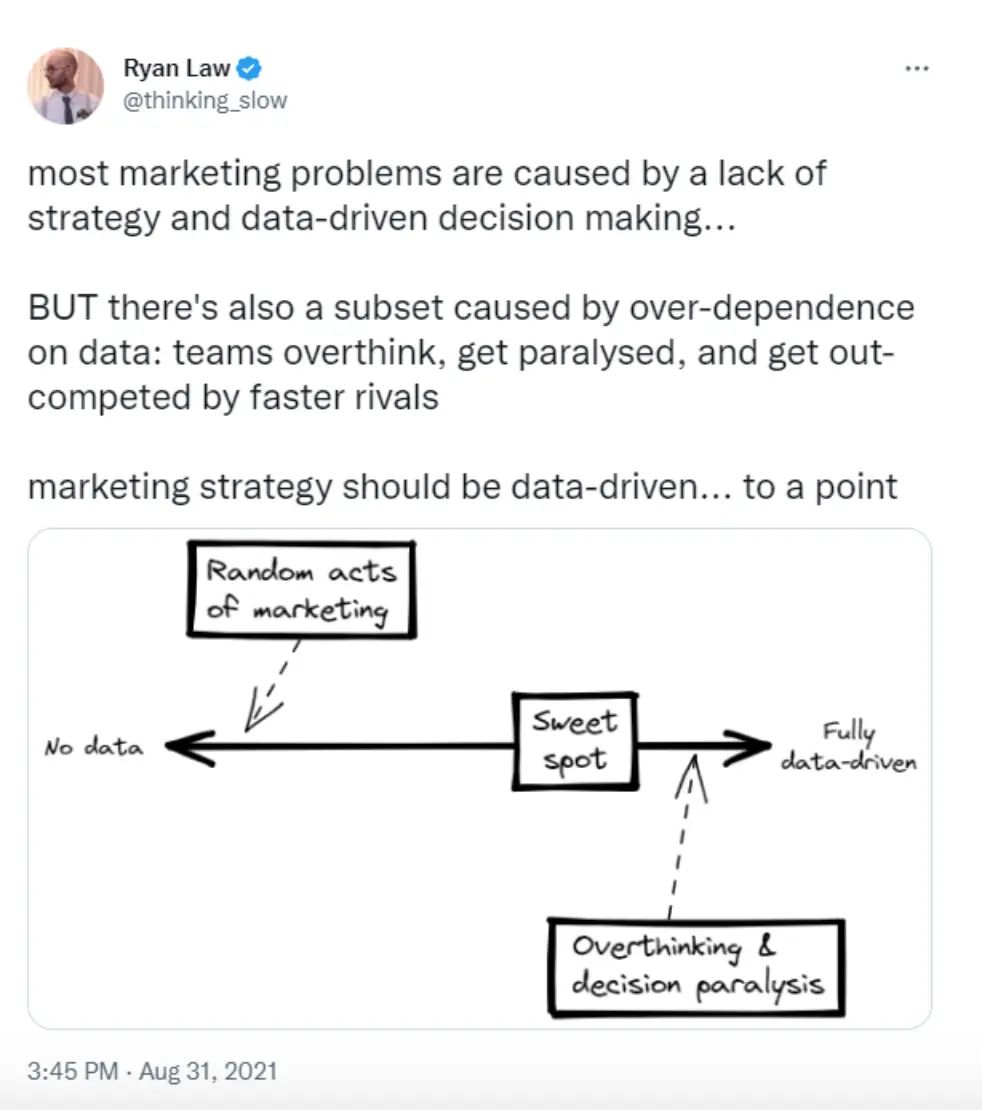Every marketer knows the importance of tracking analytics to improve over time and stay relevant. But it has its challenges, which can be quite tricky to overcome.
Equipped with the correct data, companies can understand their target market well. It enables them to position their products and personalize their services for improved results.
Since analytics comprise statistics, predictive modeling, and machine learning, businesses get a clear insight into consumer data. Despite its many benefits, marketing analytics remains one of the biggest challenges in the field.
According to a press release, Gartner expects 60% of CMOs to cut down the marketing analytics department in half by 2023 due to “failed promised improvements.” Most marketers need the right strategies and processes to overcome common analytics roadblocks.
6 Critical Marketing Analytics Pitfalls To Avoid And Ways To Fix Them
- Data usage knowledge
- Collecting more data than necessary
- Depending solely on collected data
- Inability to recognize trends
- No transparency
- Using the wrong tools
Let's review these 6 marketing analytics missteps in more detail and discuss how to manage them.
-
Data usage knowledge
Collecting user data is just the first step. Most organizations need to read the collected data accurately. A Qlik/ Accenture report highlighted 74% of employees felt overwhelmed by data.

Source: TrustRadius
The lack of knowledge in dissecting the data hinders the business’s potential for growth. If your marketing team doesn’t understand these datasets' implications, they can’t bring valuable change.
Business data is more than just a set of numbers. They represent a brand’s performance in marketing campaigns and where they stand against its competitors. With an increasingly digitized market, data-driven decisions are more critical than ever.
Marketers have a complete record of how many visitors engage with their email marketing campaign, watch the marketing videos, engage with their social media campaigns, and click on their banner ads.
Each of these data is valuable in measuring the brand’s marketing prowess. But failing to grasp their exact worth and how they can contribute to business operations is one of the pitfalls organizations face.
Solution: The best way to solve this is to upskill your marketing team in data analytics. Many courses are available online. Marketing leaders can offer these courses to their teammates.
You can also facilitate collaboration between the marketing team and the IT team. It will help your team grab the basics of analyzing marketing data.
-
Collecting too much data
Many organizations practice this misconception of thinking more data represents more insights. With ongoing digitization, the daily amount of data continues to grow. This abundance of data can lead you to make the wrong decisions.
Collecting a wide range of customer data is vital to understand the market. But overloading the system with massive data sets and cluttering the analytics operation can become counterproductive.
You may collect irrelevant data sets and waste time and resources on them. It can also lead you to miss out on information that matters.
If you collect more data from a wide range of fields, you can get information that is too varied to be helpful. It can create gaps in the results, and you will get incomplete, inaccurate, and confusing insights.
Data overload will make it difficult for you to turn them into actionable insights. Instead of a definite conclusion, you will likely come up with a lot of confusion and doubts about customer behavior. As a result, you won’t be able to make proper changes, and all the efforts will go in vain.
If that wasn’t enough, the same Qlik/ Accenture report shared that data overload results in productivity costs of 100+ billion in the US alone.

Source: Accenture
Solution: Before you collect marketing data, it’s wise to understand your business objectives in the first place. Find answers to questions like what you want to achieve through this data.
Knowing what you want to achieve will give your marketing analytics a journey in the proper direction. That way, you can cut through the noise, identify the highly-relevant KPIs and measure them correctly.
You can also use AI-powered marketing tools that bring real-time data crucial for making intelligent business decisions.
-
Extreme dependence on data

Source: Ryan Law
A data-driven approach is necessary to run brilliant, enhanced marketing campaigns that suit customer needs. But there are better ways to go than overreliance on data.
Marketers must remember that basing every decision on data without considering business goals can result in massive marketing failures. The data is there to support your choices. It should not be the sole driving force of every operation.
Extreme dependence on data provides overconfidence in your marketing strategy and prevents you from seeing the evidence gaps. It also stops you from focusing on the bigger picture.
Each KPI overlaps with other important metrics. You must strike a balance to focus on one less important metric while ignoring a visible improvement opportunity.
Solution: An intelligent balance of marketing intuition and real-time insights is necessary to avoid overreliance on data. Always consider your future goals while making a decision based on gathered data. Examine how that decision would impact your business growth and plan your marketing activities accordingly.
Set specific short-term and long-term goals and map a clear path. Focus on the most crucial aspect of your efforts– the audience and potential customers.
You must ensure that anything you do with the information falls directly in line with what you want to accomplish.
For example, if your immediate marketing goal is to increase your follower base, you can identify data like engagement and reach and take measures to optimize them.
For long-term goals like increasing traffic to your website, you can measure the performance of your CTAs and online banner ads to improve your strategy.
-
Inability to predict future trends

Source: Marketing In Asia
Customer needs are ever-changing, and the market is cutthroat. To run effective marketing campaigns, getting ahead of your customer's preferences and needs is paramount.
Data is crucial here to enhance your campaigns and explain your marketing ROI. With that, the constantly evolving customer needs are almost impossible to understand and predict future trends.
Every trend is an opportunity to boost reach. You must catch up on even one relevant trend to prevent competitors from outshining you.
Your strategy must accommodate the changes in audience needs. Without that, you can’t make any tangible or positive changes.
Solution: To keep up with every relevant trend, you must track data over regular intervals. Identify well-defined metrics that align with your business goals.
You can leverage AI and custom notifications for relevant online conversations to make the process seamless. It will help you identify trends in real-time, measure their popularity, and draw meaningful insights about your target audience.
Neal Taparia, the founder of Cribbage Online, explains, “Our marketing analytics tool provides us with daily reports of week-over-week and year-of-year trends of our KPIs. It allows us to quickly identify new or worrisome trends our team can address.”
-
Lack of transparency
Another glaring challenge marketers face is the need for more transparency due to inconsistent data.
Many marketers need a clear idea of the origins of their data sources. It prevents them from putting solid confidence in the data and analytics that drive their customer insights. The issue is so significant it even birthed new companies like Beacon.
![]()
Source: Beacon
To drive measurable results, transparency and data ownership are essential elements of any marketing strategy. While surfacing new customers and potential leads should be the most important quality of any data set, more than poor sourcing is needed to improve the process tremendously.
If marketers are not sure whether their data is coming from the in-market consumers and delivering the right insights, they can’t change the ROI positively.
Solution: When it comes to data transparency, your team, processes, and data sources need to align clearly. As a marketing team leader, you must ensure a data-driven mindset among all your team members. Make sure you have tools, people, and processes in place to preserve the reliability and transparency of your customers’ data over time.
-
Using the wrong tools

Source: Accenture
With the rising focus on marketing efforts, several marketing and analytics tools are available. One of the most prominent challenges marketers face is choosing the right one for their business.
The more your business grows, the more crucial marketing improvements will become. Marketing leaders often choose a tool with more valuable and scalable features among the many available options.
The most evident reason for this confusion is the need for more thorough research on different tools' business needs, features, and success rates. A wrong choice of marketing tools may incur extra costs and even be an additional problem.
Solution: To choose the right analytics tool, clearly understand your business goals first. Map out your budget. See how much room you can make to fit in the expenses of a proper and relevant SaaS subscription.
Having a clear idea of budget and needs will narrow down your search. Consider your marketing and sales capabilities and opt for the tool that accommodates your team and your business’s scalability.
Conclusion
Marketing analytics is important because it helps the marketing team create a data-driven marketing strategy. Running precise analytics can show you what parts of your initiatives are working and which areas need improvement.
But for it to work, you must take strategic measures to overcome the common but very impactful marketing analytics challenges.
Instead of holding on to every nugget of collected data, identify the ones capable of making a quantifiable difference. Upskill your workforce and familiarise them with the concept of data analytics.
Use the right tools to collect and decipher data and practice data transparency. With a proactive focus on all the above solutions, your marketing strategy will bridge the gaps and drive positive and tangible improvements to your ROI.

Alain Glaeser is a software developer, growth marketer, and no-code SaaS enthusiast. At BrowseDev, he shares his experience in tech and startups to empower non-tech startup founders with the knowledge to build and grow an online business.

